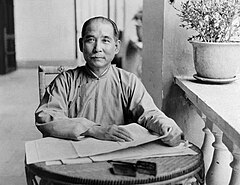 Global Information
Global InformationHistory of the Kuomintang information
| Part of a series on the |
| History of China |
|---|
|
| History of the Republic of China |
|---|
 |
|
|
|
| Part of a series on |
| Three Principles of the People |
|---|
 |
|
The Kuomintang (KMT) is a Chinese political party that ruled mainland China from 1927 to 1949 prior to its relocation to Taiwan as a result of the Chinese Civil War. The name of the party translates as "China's National People's Party" and was historically referred to as the Chinese Nationalists. The Party was initially founded on 23 August 1912, by Sun Yat-sen but dissolved in November 1913. It reformed on October 10, 1919, again led by Sun Yat-sen, and became the ruling party in China. After Sun's death, the party was dominated from 1927 to 1975 by Chiang Kai-shek. After the KMT lost the civil war with the Chinese Communist Party in 1949, the party retreated to Taiwan and remains a major political party of the Republic of China based in Taiwan.
Founded in 1912 by Sun Yat-sen, the KMT helped topple the Qing dynasty and promoted modernization along Western lines. The party played a significant part in the first Chinese first National Assembly where it was the majority party. However the KMT failed to achieve complete control. The post of president was given to Yuan Shikai (1859–1916) as reward for his part in the revolution. Yuan Shikai abused his powers, overriding the constitution and creating strong tensions between himself and the other parties. In July 1913, the KMT staged a 'Second Revolution' to depose Yuan. This failed and the following crack down by Yuan led to the dissolution of the KMT and the exile of its leadership, mostly to Japan. Subsequently, Yuan Shikai had himself made Emperor of China.
In exile, Sun Yat-sen and other former KMT members founded several revolutionary parties under various names but with little success. These parties were united by Sun in 1919 under the title "The Kuomintang of China". The new party returned to Guangzhou in China in 1920 where it set up a government but failed to achieve control of all of China. After the death of Yuan Shikai in 1916, China fractured into many regions controlled by warlords. To strengthen the party's position, it accepted aid and support from the Soviet Union and its Comintern. The fledgling Chinese Communist Party was encouraged to join the KMT and thus formed the First United Front. The KMT gradually increased its sphere of influence from its Guangzhou base. Sun Yat-sen died in 1925 and Chiang Kai-shek (1887–1975) became the KMT strong man. In 1926 Chiang led a military operation known as the Northern Expedition against the warlords that controlled much of the country. In 1927, Chiang instigated the April 12 Incident in Shanghai in which the Chinese Communist Party and Communist elements of the KMT were purged.[1] The Northern Expedition proved successful and the KMT party came to power throughout China (except Manchuria) in 1927 under the leadership of Chiang. The capital of China was moved to Nanjing in order to be closer to the party's strong base in southern China.
The party was always concerned with strengthening Chinese identity at the same time it was discarding old traditions in the name of modernity. In 1929, the KMT government suppressed the textbook Modern Chinese History, widely used in secondary education. The Nationalists were concerned that, by not admitting the existence of the earliest emperors in ancient Chinese history, the book would weaken the foundation of the state. The case of the Modern Chinese History textbook reflects the symptoms of the period: banning the textbook strengthened the Nationalists' ideological control but also revealed their fear of the New Culture Movement and its more liberal ideological implications. The KMT tried to destroy the Communist party of Mao Zedong, but was unable to stop the invasion by Japan, which controlled most of the coastline and major cities, 1937–1945. Chiang Kai-shek secured massive military and economic aid from the United States, and in 1945 became one of the five permanent members of the UN Security Council, with a veto. The KMT governed most of China until it was defeated in the civil war by the Communists in 1949.
The leadership, the remaining army, and hundreds of thousands of businessmen and other supporters, two million in all, fled to Taiwan. They continued to operate there as the "Republic of China" and dreamed of invading and reconquering what they called "mainland China". The United States, however, set up a naval cordon after 1950 that has since prevented an invasion in either direction. The KMT kept the island under martial law for 38 years under rule by Chiang Kai-shek and his son Chiang Ching-kuo (1910–1988). As the original leadership died off, it made a peaceful transition to democracy, with full election of parliament in the early 1990s and first direct presidential election in 1996. After a defeat by the Democratic Progressive Party in 2000, the KMT returned to power in the elections of 2008 and 2012.
- ^ The event is also known as the Shanghai Massacre of 1927. See Tien-wei Wu, "A Review of the Wuhan Debacle: the Kuomintang-Communist Split of 1927". Journal of Asian Studies 1969 29(1): 125–143